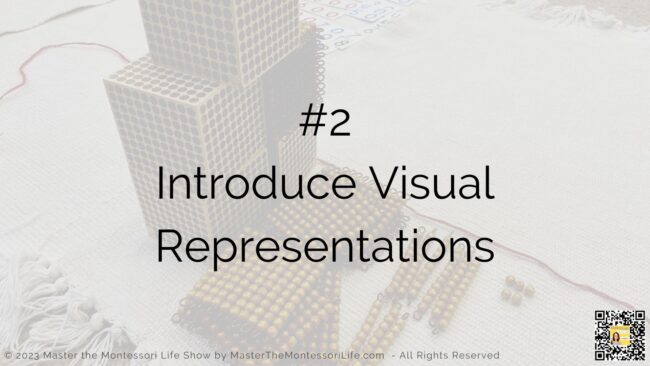In this training, we will be discussing how to teach addition using the Montessori Method.
Montessori Math is a unique hands-on approach to teaching mathematics, designed to ignite a child’s natural curiosity and love for numbers. Unlike traditional teaching methods, Montessori Math encourages children to explore mathematical concepts at their own pace and through self-discovery. In this training, we will be discussing how to teach addition using the Montessori Method.
The Montessori philosophy creates a joyful and engaging learning experience which can foster a deep, long-lasting understanding of mathematical principles, making everyday things like addition feel like an exciting adventure for the child.

Watch & Listen to the Episode Here:
As you watch or listen to this training, know that you will be able to get more information than what is included in this blog post.
However, I really want to encourage you to take the time to watch or listen and take notes.
Importantly, this will be helpful to you now and in the future.

1 Use Concrete Materials
The first step in teaching addition the Montessori way is to use concrete materials. Montessori Math emphasizes on the use of tangible learning aids like number rods, beads, or spindles. For instance, when demonstrating the addition of 2 and 3, you would first provide the child with two separate rods or bead bars, one representing 2 and the other 3.
Then, bring them together to visually and physically represent the sum. This hands-on approach allows children to visualize the concept of addition, making it more intuitive and comprehensible.

To further enhance understanding, you can incorporate a variety of concrete materials into the learning process. For instance, you might introduce addition using colorful counters or sandpaper numbers. This sensory engagement aids in grasping the abstract concept of addition.
Children can physically touch and manipulate these materials, seeing the number “5” as a collection of five separate units. This multi-sensory approach not only anchors the concept of addition in a child’s mind, but also makes learning a fun and interactive experience. Remember, the key is to allow children to explore and discover the joy of learning at their own pace.

Montessori Math Four Operations: Addition + Lesson Plan
$2.99
This Montessori Math Four Operations activity focuses on addition. It includes a helpful step by step lesson plan.
Children ages 3-6 will be learning about the Montessori 4 Operations (addition, subtraction, multiplication and division). In this set, children will focus on ADDITION activities. It includes detailed step by step lesson plan.
EU BUYERS, GO HERE.
2 Introduce Visual Representations
Once the student feels comfortable with concrete materials, introduce them to visual representations of addition, like number lines or ten frames. This will help build a bridge between abstract concepts and real-world examples in their minds.
Start by drawing two number lines, each representing one of the addends. Then, have your student connect the lines with a line to represent the sum. This visual representation will help them understand addition as a process of combining two parts into one whole.

You can also ask your students to label each number line with the corresponding addend (e.g. “2 + 3”). This will help them internalize the concept of addition as a mathematical operation. Following the visual representation exercise, reinforce the concept with written equations. This can be as simple as writing “2 + 3 = 5” on a chalkboard or using magnetic numbers on a metal sheet.
Encourage the child to write out the equation and then demonstrate it using the number rods or beads. This exercise combines the concrete, visual, and abstract aspects of Montessori Math, solidifying the child’s understanding of addition. Remember, practicing this process repeatedly and with different numbers is key to mastering addition the Montessori way.

Montessori Math Four Operations: Addition & Subtraction + Lesson Plans
$4.99
This Montessori Math Four Operations activity focuses on addition and subtraction. It includes a helpful step by step lesson plan.
Children ages 3-6 will be learning about the Montessori 4 Operations (addition, subtraction, multiplication and division). In this set, children will focus on ADDITION & SUBTRACTION activities. It includes detailed step by step lesson plan.
EU BUYERS, GO HERE.
3 Practice Math Facts
The final step is to start practicing and memorizing math facts with your students using the materials they’ve learned with so far. Ask them simple questions like “what is 2 plus 3?” and have them use their fingers to point out the answer. As they progress, move on to more difficult math facts and equations.
By using Montessori Math, teachers can help their students develop a meaningful understanding of addition and other mathematical concepts. It is a great way to foster an appreciation for numbers in children and spark their natural curiosity about mathematics.

Using this method will also make learning math fun for your students and help foster their enthusiasm in the subject. Through these strategies, teachers can inspire their students to develop a lifelong love of mathematics!
You can also supplement the Montessori Method with other activities like games and worksheets which will further enhance learning comprehension and engage your students in mathematical exploration. By introducing interesting activities that involve addition, children can have a better understanding of math concepts and have a foundation for more complex mathematical operations down the line.

Montessori Math Four Operations: BUNDLE OF 4 + Lesson Plans
$7.00
Children ages 3-6 will be learning about the Montessori 4 Operations (addition, subtraction, multiplication and division). In this set, children will focus on ALL FOUR OPERATIONS with hands-on activities. It includes detailed step by step lesson plan.
EU BUYERS, GO HERE.
Key Takeaways
- Use concrete materials to demonstrate addition.
- Introduce visual representations of addition such as number lines and ten frames.
- Practice math facts with your students using the materials they’ve learned so far.
- Supplement the Montessori Method with games and worksheets to further enhance learning comprehension.
- Inspire your students to develop a lifelong love of mathematics.
By following these steps, you can teach addition using the Montessori Method with ease and help your students understand this fundamental mathematical concept better. With a little patience and lots of encouragement, you can help them become confident in their math skills and have fun while learning!
With these strategies in mind, you can help your students learn addition in an exciting and enjoyable way! Make sure to use concrete materials like number rods, beads, and spindles along with visual representations such as number lines or ten frames to easily and effectively demonstrate the concept of addition.
Additionally, practice math facts with your students to help them deepen their understanding and apply it in real-world settings. By leveraging Montessori Math and supplementing it with other activities, you will be able to create a vibrant learning environment where students can have fun while discovering mathematical concepts.
Happy teaching!
Resources mentioned in training


Montessori Curriculum Math Starter Record Chart
$2.99
When thinking about Montessroi Math, you can be intimidated by that.
But don’t fret. Here is a great way to get started!
You will get a checklist with some of the first Montessori works that you can start with and a list of resources with clickable links that can help you along.
EU buyers, go here.
Like I said at the beginning of the show, I have a FB group for all things Montessori that you are welcome to join.
It is called The Montessori Way Prep Room.
If you want to join a homeschool Facebook community, then join The Natural Homeschool Community!
Wardrobe from: http://bit.ly/TNHstitchfix
You May Also Benefit from these Important Montessori Topics:
As you learn more about Master The Montessori Life, you will realize just how much I strive to make your life easier.
I also seek to equip you, to inform you and to give you made-for-you options so you can keep moving forward on your Montessori journey without any speed bumps.
- Unveiling the Beauty of Montessori in the Environment
 In the world of Montessori education, aesthetics, also known as the beauty of Montessori, do a lot more than just make things look nice.
In the world of Montessori education, aesthetics, also known as the beauty of Montessori, do a lot more than just make things look nice. - Teaching Addition the Montessori Way: A Guide to Making Math Engaging for Children
 This blog post will explore three key points that outline the Montessori method of teaching addition.
This blog post will explore three key points that outline the Montessori method of teaching addition. - Teaching Sight Words the Montessori Way
 This training will explain how parents and teachers can use the Montessori approach to teaching sight words in an effective and engaging way.
This training will explain how parents and teachers can use the Montessori approach to teaching sight words in an effective and engaging way.







Leave a Reply